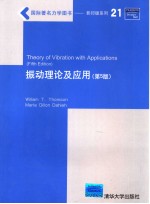

振动理论及应用 第5版PDF电子书下载
- 电子书积分:16 积分如何计算积分?
- 作 者:汤姆逊(Thomson,W.T.),达利(Dahleh,M.D.)著
- 出 版 社:清华大学出版社
- 出版年份:2005
- ISBN:7302121370
- 页数:524 页
THE SI SYSTEM OF UNITS 1
CHAPTER 1 OSCILLATORY MOTION 5
1.1 Harmonic Motion 6
1.2 Periodic Motion 9
1.3 Vibration Terminology 11
CHAPTER 2 FREE VIBRATION 16
2.1 Vibration Model 16
2.2 Equation of Motion: Natural Frequency 16
2.3 Energy Method 20
2.4 Rayleigh Method: Effective Mass 23
2.5 Principle of Virtual Work 25
2.6 Viscously Damped Free Vibration 27
2.7 Logarithmic Decrement 31
2.8 Coulomb Damping 35
CHAPTER 3 HARMONICALLY EXCITED VIBRATION 49
3.1 Forced Harmonic Vibration 49
3.2 Rotating Unbalance 53
3.3 Rotor Unbalance 56
3.4 Whirling of Rotating Shafts 59
3.5 Support Motion 63
3.6 Vibration Isolation 65
3.7 Energy Dissipated by Damping 67
3.8 Equivalent Viscous Damping 70
3.9 Structural Damping 72
3.10 Sharpness of Resonance 74
3.11 Vibration-Measuring Instruments 75
CHAPTER 4 TRANSIENT VIBRATION 89
4.1 Impulse Excitation 89
4.2 Arbitrary Excitation 91
4.3 Laplace Transform Formulation 94
4.4 Pulse Excitation and Rise Time 97
4.5 Shock Response Spectrum 100
4.6 Shock Isolation 104
4.7 Finite Difference Numerical Computation 105
4.8 Runge-Kutta Method 112
CHAPTER 5 SYSTEMS WITH TWO OR MORE DEGREES OF FREEDOM 126
5.1 The Normal Mode Analysis 127
5.2 Initial Conditions 131
5.3 Coordinate Coupling 134
5.4 Forced Harmonic Vibration 139
5.5 Finite Difference Method for Systems of Equations 141
5.6 Vibration Absorber 144
5.7 Centrifugal Pendulum Vibration Absorber 145
5.8 Vibration Damper 147
CHAPTER 6 PROPERTIES OF VIBRATING SYSTEMS 163
6.1 Flexibility Influence Coefficients 164
6.2 Reciprocity Theorem 167
6.3 Stiffness Influence Coefficients 172
6.4 Stiffness Matrix of Beam Elements 176
6.5 Static Condensation for Pinned Joints 176
6.6 Orthogonality of Eigenvectors 177
6.7 Modal Matrix 179
6.8 Decoupling Forced Vibration Equations 181
6.9 Modal Damping in Forced Vibration 182
6.10 Normal Mode Summation 183
6.11 Equal Roots 187
6.12 Unrestrained (Degenerate) Systems 189
CHAPTER 7 LAGRANGE’S EQUATION 199
7.1 Generalized Coordinates 199
7.2 Virtual Work 204
7.3 Lagrange’s Equation 207
7.4 Kinetic Energy, Potential Energy,and Generalized Force in Terms of Generalized Coordinates q 214
7.5 Assumed Mode Summation 216
CHAPTER 8 COMPUTATIONAL METHODS 227
8.1 Root Solving 227
8.2 Eigenvectors by Gauss Elimination 229
8.3 Matrix Iteration 230
8.4 Convergence of the Iteration Procedure 233
8.5 The Dynamic Matrix 233
8.6 Transformation Coordinates (Standard Computer Form) 234
8.7 Systems with Discrete Mass Matrix 235
8.8 Cholesky Decomposition 237
8.9 Jacobi Diagonalization 242
8.10 QR Method for Eigenvalue and Eigenvector Calculation 247
CHAPTER 9 VIBRATION OF CONTINUOUS SYSTEMS 258
9.1 Vibrating String 268
9.2 Longitudinal Vibration of Rods 271
9.3 Torsional Vibration of Rods 273
9.4 Vibration of Suspension Bridges 276
9.5 Euler Equation for Beams 281
9.6 System with Repeated Identical Sections 286
CHAPTER 10 INTRODUCTION TO THE FINITE ELEMENT METHOD 287
10.1 Element Stiffness and Mass 287
10.2 Stiffness and Mass for the Beam Element 292
10.3 Transformation of Coordinates(Global Coordinates) 295
10.4 Element Stiffness and Element Mass in Global Coordinates 297
10.5 Vibrations Involving Beam Elements 302
10.6 Spring Constraints on Structure 309
10.7 Generalized Force for Distributed Load 311
10.8 Generalized Force Proportional to Displacement 313
CHAPTER 11 MODE-SUMMATION PROCEDURESFOR CONTINUOUS SYSTEMS 329
11.1 Mode-Summation Method 329
11.2 Normal Modes of Constrained Structures 335
11.3 Mode-Acceleration Method 339
11.4 Component-Mode Synthesis 341
CHAPTER 12 CLASSICAL METHODS 351
12.1 Rayleigh Method 351
12.2 Dunkerley’s Equation 358
12.3 Rayleigh-Ritz Method 363
12.4 Holzer Method 366
12.5 Digital Computer Program for the Torsional System 369
12.6 Myklestad’s Method for Beams 371
12.7 Coupled Flexure-Torsion Vibration 375
12.8 Transfer Matrices 376
12.9 Systems with Damping 378
12.10 Geared System 380
12.11 Branched Systems 381
12.12 Transfer Matrices for Beams 383
CHAPTER 13 RANDOM VIBRATIONS 395
13.1 Random Phenomena 395
13.2 Time Averaging and Expected Value 396
13.3 Frequency Response Function 398
13.4 Probability Distribution 401
13.5 Correlation 407
13.6 Power Spectrum and Power Spectral Density 411
13.7 Fourier Transforms 417
13.8 FTs and Response 424
CHAPTER 14 NONLINEAR VIBRATIONS 436
14.1 Phase Plane 436
14.2 Conservative Systems 438
14.3 Stability of Equilibrium 441
14.4 Method of Isoclines 443
14.5 Perturbation Method 445
14.6 Method of Iteration 448
14.7 Self-Excited Oscillations 451
14.8 Runge-Kutta Method 453
APPENDICES 462
A Specifications of Vibration Bounds 462
B Introduction to Laplace Transformation 464
C Determinants and Matirces 469
D Normal Modes of Uniform Beams 479
E Introduction to MATLAB? 487
F Computer Programs 492
G Convergence to Higher Modes 501
ANSWERS TO SELECTED PROBLEMS 506
INDEX 519
- 《钒产业技术及应用》高峰,彭清静,华骏主编 2019
- 《现代水泥技术发展与应用论文集》天津水泥工业设计研究院有限公司编 2019
- 《英汉翻译理论的多维阐释及应用剖析》常瑞娟著 2019
- 《数据库技术与应用 Access 2010 微课版 第2版》刘卫国主编 2020
- 《区块链DAPP开发入门、代码实现、场景应用》李万胜著 2019
- 《虚拟流域环境理论技术研究与应用》冶运涛蒋云钟梁犁丽曹引等编著 2019
- 《当代翻译美学的理论诠释与应用解读》宁建庚著 2019
- 《第一性原理方法及应用》李青坤著 2019
- 《教师教育系列教材 心理学原理与应用 第2版 视频版》郑红,倪嘉波,刘亨荣编;陈冬梅责编 2020
- 《物联网与嵌入式技术及其在农业上的应用》马德新 2019
- 《如何指导博士生学术写作 给导师的教学法》(澳)芭芭拉·凯姆勒(Barbara Kamler),帕特·托马斯(Pat Thomson)著 2020
- 《跑起来,只为认真对自己》(美)汤姆·福尔曼,创美工厂出品 2020
- 《奥兹的智慧 勇担个人责任,站到成功线上 修订版》(美)Roger Connors(罗杰·康纳斯),(美)Tom Smith(汤姆·史密斯) 2019
- 《玩转爵士乐 即兴演奏自学宝典》汤姆·沃尔士(TomWalsh),薛莉山(XueLishan)著 2019
- 《恐龙时代》(英)汤姆逊著 2009
- 《学前训练 数学篇》《会说话的汤姆猫家族》出版策划团队编 2017
- 《价格谈判》(美)汤姆·赖利(TomReilly)著 2013
- 《复合材料力学导论》(美)蔡为仑,赫·汤姆斯·韩著;于德昌,李顺林等译 1981
- 《哈佛百年经典 11卷 科学论文集:物理学、化学、天文学、地质学》(英)法拉第,(德)赫姆霍兹,(爱尔兰)汤姆森等著;(美)查尔斯·艾略特主编;翟蓉译 2013
- 《近代科学家的宗教观》(英)汤姆生(J.A.Thomson))著;谢颂羔,米星如译 1928
